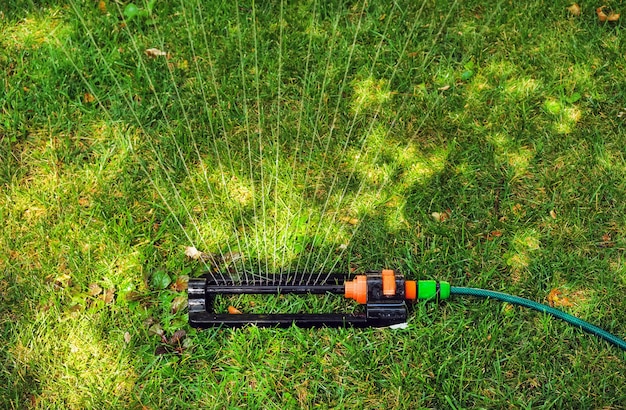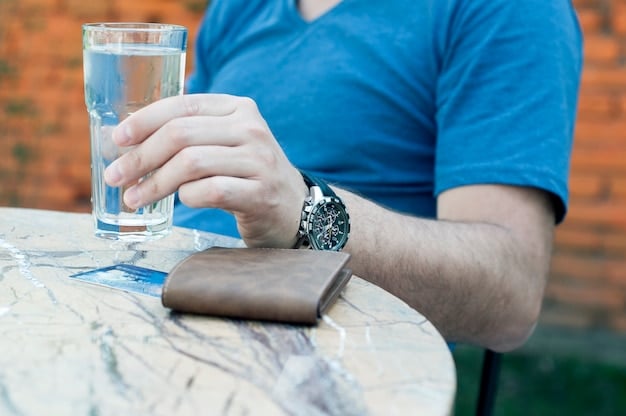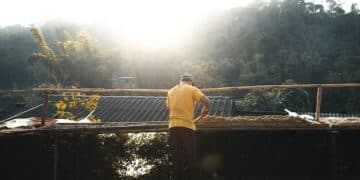Water Conservation Tips: Save Money This Summer

Water conservation tips are essential for reducing your water bill this summer, focusing on simple changes both indoors and outdoors to help you save money and contribute to environmental sustainability.
Summer heat can lead to increased water usage, but with the right strategies, you can implement effective water conservation tips to reduce your water bill by 20% and ensure the water is used wisely.
Understand Your Water Usage
Before implementing any water conservation strategies, it’s crucial to understand how much water you’re currently using. This baseline will help you track your progress and identify areas where you can make the most significant impact.
Understanding your water consumption patterns can reveal surprising insights into where you’re using the most water and provides a strong foundation for targeted conservation efforts.
Check Your Water Meter Regularly
Reading your water meter is a simple yet effective way to monitor your water usage. By checking it regularly, you can identify spikes in consumption and address potential issues like leaks promptly.
Analyze Your Water Bill
Your water bill provides a breakdown of your water usage over time. Reviewing past bills can help you identify seasonal trends and understand how your water consumption changes throughout the year.
- Track your average monthly water usage.
- Compare your water usage to previous years.
- Look for any unusual spikes or dips in consumption.
By carefully analyzing your water usage patterns, you can pinpoint specific areas where you can make improvements. This data-driven approach ensures you’re focusing your efforts on the most impactful conservation tips.

Understanding your water usage is the first step towards effective water conservation. Once you have a clear picture of your consumption patterns, you can start implementing targeted strategies to reduce your water bill and conserve this valuable resource.
Indoor Water Conservation Strategies
Many opportunities to conserve water exist inside your home, and implementing simple changes in your daily routine can significantly reduce your water usage.
From fixing leaks to adopting water-efficient appliances, indoor water conservation can make a substantial difference in your water bill and environmental impact. Here’s how to get started.
Fix Leaks Promptly
Even small leaks can waste a significant amount of water over time. Make it a priority to fix any leaks as soon as you discover them, whether it’s a dripping faucet or a running toilet.
Install Water-Efficient Fixtures
Upgrading to water-efficient fixtures is an investment that pays off in the long run. Look for WaterSense-labeled products, which are certified to use less water without sacrificing performance.
- Replace old toilets with dual-flush or low-flow models.
- Install low-flow showerheads to reduce water consumption during showers.
- Use faucet aerators to reduce water flow without compromising water pressure.
Simple changes in your daily habits can also make a big difference. For example, taking shorter showers, turning off the faucet while brushing your teeth, and only running full loads of laundry and dishes can all help reduce your water consumption.
By implementing these indoor water conservation strategies, you can significantly reduce your water bill and contribute to a more sustainable lifestyle.
Outdoor Water Conservation Techniques
Outdoor water usage often accounts for a significant portion of your total water consumption, especially during the summer months. Implementing effective outdoor water conservation techniques is essential for reducing your water bill and minimizing your environmental impact.
From smart irrigation practices to drought-tolerant landscaping, there are many ways to conserve water in your yard and garden. Let’s explore some strategies.

Optimize Your Irrigation System
An efficient irrigation system is crucial for conserving water outdoors. Make sure your sprinkler system is properly adjusted to avoid overwatering and water waste.
Choose Drought-Tolerant Plants
Selecting drought-tolerant plants for your landscaping is a great way to reduce your water needs. Native plants are well-adapted to your local climate and require less water than non-native species.
- Group plants with similar water needs together.
- Use mulch to retain moisture in the soil.
- Consider xeriscaping, a landscaping technique that minimizes water use.
Collecting rainwater is another effective way to conserve water outdoors. Rain barrels can be used to collect rainwater from your roof, which can then be used to water your garden or lawn.
By adopting these outdoor water conservation techniques, you can significantly reduce your water consumption and create a more sustainable landscape.
Smart Landscaping for Water Conservation
Smart landscaping not only enhances the beauty of your property but also plays a crucial role in water conservation. By making informed choices about plant selection, soil management, and irrigation practices, you can create a landscape that thrives with minimal water usage.
Designing a water-efficient landscape involves careful planning and consideration of various factors, including climate, soil type, and plant needs. Here’s how to approach it.
Choose the Right Plants
Selecting plants that are well-suited to your local climate is essential for water conservation. Native plants are generally the best choice, as they are adapted to the local soil and rainfall patterns.
Improve Your Soil
Healthy soil is better able to retain moisture, reducing the need for frequent watering. Amend your soil with organic matter, such as compost or aged manure, to improve its water-holding capacity.
- Use mulch to suppress weeds and retain moisture.
- Aerate your soil to improve drainage and air circulation.
- Consider using soil conditioners to improve soil structure.
Smart landscaping also involves efficient irrigation practices. Use drip irrigation or soaker hoses to deliver water directly to plant roots, minimizing water loss through evaporation. Water deeply but less frequently to encourage deep root growth.
By implementing these smart landscaping techniques, you can create a beautiful and sustainable outdoor space that conserves water and reduces your environmental impact.
Water-Efficient Appliances and Fixtures
Upgrading to water-efficient appliances and fixtures is a wise investment that can lead to significant water savings over time. These appliances are designed to use less water without compromising performance, helping you reduce your water bill and conserve this valuable resource.
From toilets to washing machines, there are many water-efficient options available on the market. Here’s how to choose the right ones.
Look for WaterSense Labels
The WaterSense label is a program of the U.S. Environmental Protection Agency (EPA) that identifies water-efficient products. Look for this label when purchasing toilets, showerheads, faucets, and other water-using fixtures.
Consider High-Efficiency Washing Machines
High-efficiency washing machines use significantly less water than traditional models. Look for front-loading machines, which typically use less water than top-loading machines.
- Choose a washing machine with a low water factor rating.
- Run full loads of laundry whenever possible.
- Use cold water to wash clothes whenever appropriate.
Installing water-efficient toilets can also make a big difference in your water consumption. Dual-flush toilets, for example, allow you to use less water for liquid waste.
By investing in water-efficient appliances and fixtures, you can significantly reduce your water usage and contribute to a more sustainable future.
Monitor and Adjust Your Water Usage
Conserving water is an ongoing process that requires continuous monitoring and adjustment. Regularly assessing your water usage and making necessary changes can help you maximize your water savings and maintain a sustainable lifestyle.
Monitoring your water usage involves tracking your consumption patterns, identifying areas where you can make improvements, and adjusting your habits and practices accordingly. Here’s how to stay on top of it.
Track Your Water Bill
Continue to monitor your water bill regularly to track your consumption patterns. Look for any unusual spikes or dips in water usage and investigate the causes.
Conduct Regular Audits
Periodically conduct a water audit of your home and yard. Check for leaks, assess the efficiency of your irrigation system, and evaluate your landscaping practices.
- Use a water usage calculator to estimate your water consumption.
- Compare your water usage to similar households in your area.
- Set water conservation goals and track your progress.
Adjusting your water usage may involve making changes to your daily habits, such as taking shorter showers, turning off the faucet while brushing your teeth, and running full loads of laundry and dishes.
By continuously monitoring and adjusting your water usage, you can ensure you’re maximizing your water savings and contributing to a more sustainable future.
| Key Action | Brief Description |
|---|---|
| 💧 Fix Leaks | Repair dripping faucets and running toilets promptly. |
| 🚿 Shorter Showers | Reduce shower time to save water with each wash. |
| 🌱 Drought-Tolerant Plants | Use plants that require little water in landscaping. |
| 🚿 Efficient Appliances | Install WaterSense labeled appliances to minimize water use. |
Frequently Asked Questions
▼
Check your water meter before and after a two-hour period when no water is being used. If the meter changes, you likely have a leak. Also, check faucets and toilets for any drips or unusual sounds.
▼
WaterSense products are certified by the EPA to use less water without compromising performance. These products include toilets, showerheads, and faucet aerators, helping you save water and reduce your water bill.
▼
Use drought-tolerant plants native to your area, apply mulch to retain soil moisture, and water during cooler parts of the day to reduce evaporation. Also, consider using a drip irrigation system for targeted watering.
▼
Xeriscaping is a landscaping method designed to minimize the need for irrigation and maintenance. It involves planning and choosing drought-tolerant vegetation and proper planting techniques, reducing water use significantly.
▼
You should inspect your sprinkler system at least once a month during the watering season. Look for any leaks or misdirected spray and adjust the system accordingly to ensure efficient watering.
Conclusion
Implementing these water conservation tips can significantly reduce your water bill this summer and contribute to a more sustainable lifestyle. Take action today to conserve water and save money.





